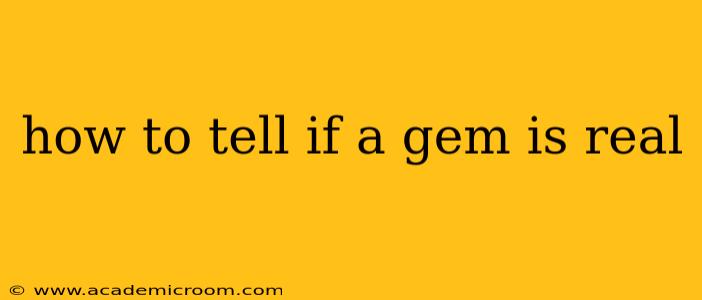How to Tell if a Gem is Real: A Comprehensive Guide
Determining the authenticity of a gem can be tricky, but with the right knowledge and techniques, you can confidently distinguish real gems from their imitations. This guide provides a comprehensive overview of various methods, helping you assess the genuineness of your precious stones. We'll explore visual inspection, testing methods, and where to seek professional help.
What are the common ways to identify fake gemstones?
Identifying fake gemstones involves a multi-pronged approach combining visual inspection, simple tests, and sometimes, professional appraisal. Many imitations rely on cheaper materials mimicking the appearance of real gemstones. Understanding these differences is key.
How can I visually inspect a gemstone for authenticity?
Visual inspection is the first step in determining if a gem is real. Look for these key indicators:
-
Clarity and Inclusions: Real gemstones often have subtle inclusions (internal flaws) or imperfections. Perfectly flawless stones are often a red flag. Examine the gem closely with a loupe (a jeweler's magnifying glass) – if it's too perfect, it might be a synthetic or imitation.
-
Color and Luster: Observe the gem's color saturation and its luster (shine). Real gemstones often possess a depth and brilliance that imitations lack. Fake stones might have an overly bright or dull appearance. Compare the stone to known examples of the gem type if possible.
-
Cut and Faceting: Examine the precision and symmetry of the gem's cut and facets. Poorly cut or unevenly faceted stones could indicate a fake. Real gemstones usually have more consistent and precise cuts.
-
Weight and Feel: Compare the weight of the stone to what you expect for its size. Some imitations might feel lighter or heavier than the genuine article due to different densities.
What are some simple tests to determine if a gem is real?
While visual inspection is crucial, certain simple tests can further aid in authentication:
-
Hardness Test: Real gemstones possess varying levels of hardness (resistance to scratching). You can cautiously test the gem's hardness by gently scratching it with a steel knife or a piece of glass. However, this should be done with extreme caution as you could damage the stone. It's generally not recommended for softer gemstones.
-
Heat Test: This involves heating the gem and observing its reaction. Some gemstones exhibit specific reactions to heat. However, this method can be risky and should only be performed by someone with experience. Incorrect application of heat can damage the stone.
-
Light Test: Hold the gem up to a strong light source. Observe how light refracts within the stone. Real gems usually display a unique pattern of refraction that imitations often lack.
What kind of tests do jewelers use to determine if a gem is real?
Professional jewelers employ sophisticated equipment and techniques to assess gem authenticity. These may include:
-
Refractometer: Measures the refractive index of a gem, a unique optical property that helps identify different gem types.
-
Spectroscope: Analyzes the gem's light absorption and emission spectrum to reveal its chemical composition.
-
UV Fluorescence: Exposes the gem to ultraviolet light to observe its fluorescence (glow) under UV light, which varies depending on the gem and its treatment.
-
Specific Gravity Test: Measures the gem's density to compare it with known values for specific gemstones.
Where can I get a gemstone professionally tested?
For definitive authentication, it's best to consult a qualified gemologist or jeweler. Reputable jewelers often have the necessary equipment and expertise to perform accurate gemstone testing. You can also find independent gemological laboratories that specialize in gemstone identification.
How much does it cost to get a gemstone professionally tested?
The cost of professional gem testing varies depending on the gem's type, size, and the complexity of the analysis required. It's best to contact local gemologists or laboratories for pricing information.
By combining visual inspection with simple tests and, when necessary, professional appraisal, you can significantly increase your confidence in determining whether a gem is real. Remember, caution and professional guidance are key when dealing with precious stones.
